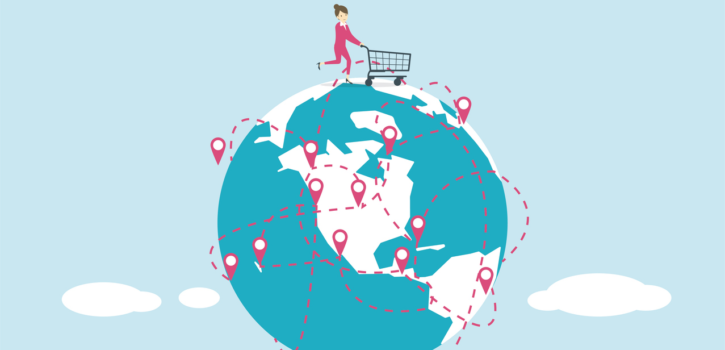E-commerce across the globe: 13 insightful stats for 2025
If becoming a leading global e-tailer tops your list, you’ll need to know exactly how it works. Why do customers choose one product over another? When customers need help, what’s their preferred method? What recent big changes have impacted e-commerce? We have compiled 13 key global e-tail statistics to help you conquer 2025. These should help you fine-tune your business strategy and boost your sales.
By 2029, the world will have 3.9 billion online shoppers.
As of September 2024, there were 2.71 billion online shoppers across the globe. This means that out of 8 billion inhabitants, about 34% of people now shop online, representing a 2.7% year-on-year increase.
What’s more, forecasts indicate that global e-commerce penetration is expected to reach 49.1% by 2029.
In 2025, 21% of retail sales are expected to be online
| So, what is retail? 🔎 Retail refers to the sale of small quantities of goods or services by a seller to the end client (usually individuals). Retail is the opposite of wholesale. |
Data-gatherer, Statista, details the share of global online retail sales from 2021 to 2027.
For 2025, the platform is expecting a market share of 21%, the highest e-tail figure to date.
It is expected to increase by 1.6% in two years to reach 22.6% by 2027.
Here’s a yearly look at online retail sales:
| Year | Share of online retail transactions |
| 2021 | 18.8 % |
| 2022 | 18.70 % |
| 2023 | 19.40 % |
| 2024 | 20.10 % |
| 2025 (forecast) | 21 % |
| 2026 (forecast) | 21.80 % |
| 2027 (forecast) | 22.60 % |
As you can see, there’s been an average year-on-year increase of 0.32% since 2021.
Global e-tail commerce turnover is expected to exceed $6.86 trillion in 2025
Another interesting global e-tail statistic: e-commerce is expected to generate $6.86 trillion in 2025, an increase of 8.37% compared to 2024.
E-commerce sales should then grow by about 7.8% between 2025 and 2027 to reach nearly $8 trillion in 2027. This growth is over double that of brick-and-mortar stores.
This key figure demonstrates that e-commerce is becoming a more profitable choice for businesses around the world.
Here is the evolution of global e-tail turnover from 2021 to 2027:
| Year | Global e-commerce turnover |
| 2021 | $4.98 trillion |
| 2022 | $5.29 trillion |
| 2023 | $5.82 trillion |
| 2024 | $6.33 trillion |
| 2025 (forecast) | $6.98 trillion |
| 2026 (forecast) | $7.41 trillion |
| 2027 (forecast) | $7.96 trillion |
The world has over 28 million online stores
2025 now counts over 28 million online stores worldwide, 2.9% more than in 2024. This equates to roughly 2,162 e-commerce sites created daily between 2024 and 2025.
Distribution-wise, the USA notably accounts for 50% of the world’s e-tail sites.
In terms of e-commerce platforms, most online stores use:
- Shopify (29 %)
- Wix (20 %)
- Woocommerce (17 %)
- SquareSpace (12 %)
- Ecwid (5 %)
- Other (18 %)
Most international customers prefer Live chat (47%) when seeking help
Nearly half of internet users (47.2%) use Live Chat when they need customer support. Phone support comes in second place with 21.6%, followed by email (14%), self-service portals (10%), and support via social networks (4.8%).
Our e-tail tip: if your e-shop doesn’t have Live Chat, put it on your to-do list ASAP.
52% of online shoppers search for products on sites abroad
Over half of online shoppers place orders on sites in other countries.
Shoppers in Mexico are the most likely to shop on international sites, and 72% of respondents say they browse both nationwide sites and those abroad before making a purchase.
Shoppers in the USA and UK are more likely to buy nationwide. 63% of respondents in these two countries say they buy from e-tailers in their own country.
Our e-tail tip: get your e-shop translated into other languages to generate https://fr.textmaster.com/blog/e-commerce-cross-border/cross-border sales.
99% of customers read online reviews before ordering
Almost all online shoppers (99%) read customer reviews before placing an order and 96% of them specifically look for negative reviews.
And they don’t question what they read! 50% of shoppers trust online reviews as much as they trust personal recommendations from family and friends. Customer reviews are therefore crucial in e-commerce.
Our e-tail tip: add a “review” block on your product sheets to encourage customers to leave scores and feedback. This will help potential customers to decide and improve your product sheets’ SEO.
Free shipping is the clincher for 53.2% of online shoppers
Another recent study, this time by Oberlo, reveals the main reasons why internauts choose to buy from a particular e-tailer.
Free delivery tops the list with 53.2% of buyers, followed by discounts, an easy returns policy, a streamlined checkout process, positive customer reviews, plus incentives that we’ve listed below:
| Advantages | Percentage |
| Free delivery | 53.2 % |
| Discounts | 40.6 % |
| Easy returns policy | 32.4 % |
| Simple payment process | 28.6 % |
| Customer reviews | 33.2 % |
| Next day delivery | 28.5 % |
| Loyalty points | 24.9 % |
| Interest-free payment by instalments | 17.0 % |
| Social media comments and likes | 23.0 % |
| Eco-friendly aspects | 18.7 % |
Our e-tail tip: offering free delivery, frequent discounts, and an easy returns policy will help increase your e-shop’s turnover.
In 2027, 62% of online purchases will be made using smartphones
The share of e-shop purchases made using smartphones is constantly on the rise.
According to Statista, it was 56% in 2018 and will increase to 62% in 2027.
This is because consumers are increasingly glued to their smartphones and e-merchants are leaping on the m-commerce bandwagon. More and more e-tailers are optimising mobile versions of their sites.
Our e-tail tip: make sure you have a responsive website. You should ensure that every step of your e-shop’s shopping experience is as enjoyable as possible for customers using a smartphone or tablet.
M-commerce sales are expected to reach $2.51 trillion in 2025
Making your e-shop m-commerce-friendly is vital as mobile sales are expected to reach $2.51 trillion in 2025, a year-on-year increase of 21.25%.
Social commerce will be worth $2.9 trillion by 2026
By 2026, social commerce will be worth $2.9 trillion, 30.81% more than the previous year.
Our e-tail tip: harness the power of social media to sell your products. For example, you can optimise your Instagram e-commerce strategy.
Facebook and Instagram are the most popular social commerce platforms
This Emarketer study looked at the most popular social commerce networks.
Facebook leads with 69.4 million shoppers in the US, representing 20% of the US population. Instagram’s next with 47.5 million shoppers in the US, while TikTok comes in a close third with 37.8 million shoppers. Pinterest comes in fourth with 18.1 million shoppers.
💡 Useful fact: 18 to 34-year-olds are the most frequent shoppers on social media.
Our e-tail tip: analyse your target customers’ age range and browsing habits. This will help you choose the right social platforms to promote your products and services.
Augmented reality is booming
Augmented reality statistics indicate a growing global importance for e-tailers:
- 32% of people already use augmented reality tools while shopping online
- 40% of consumers are willing to pay more for a product they can try before they buy thanks to augmented reality
- 9 out of 10 Gen Zers are particularly receptive to augmented reality-supported purchases
- 90% of Americans use or plan to use augmented reality for online purchases
Global e-commerce: statistics determine the best practices
The figures prove it: e-commerce continues to gain ground on physical stores. And over time, its uses and internauts’ expectations will continue to evolve.
More and more consumers are reaching for their smartphones when buying online. And most are happy to buy from other countries if delivery is free.
Free shipping, discounts, and an easy returns policy are must-haves today.
Finally, stats prove augmented reality is a growing trend, becoming an e-tail game-changer.
If you want to go a bit deeper, here’s an article on developing your e-commerce business in Europe.






